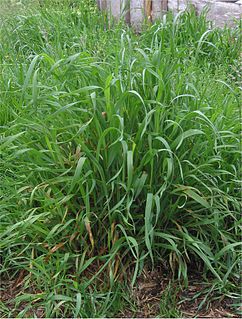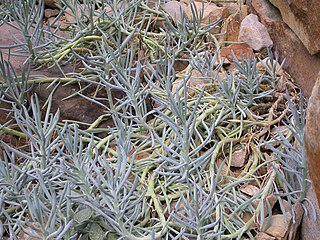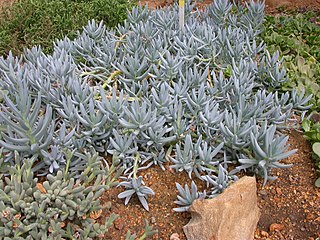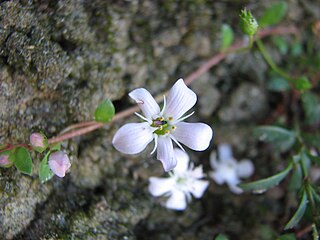
Senecio is a genus of flowering plants in the daisy family (Asteraceae) that includes ragworts and groundsels. The scientific name, Senecio, means "old man".

Ceanothus is a genus of about 50–60 species of nitrogen-fixing shrubs and small trees in the buckthorn family (Rhamnaceae). Common names for members of this genus are buckbrush, California lilac, soap bush, or just ceanothus. "Ceonothus" comes from Ancient Greek: κεάνωθος (keanōthos), which was applied by Theophrastus to an Old World plant believed to be Cirsium arvense.

Trifolium repens, the white clover, is a herbaceous perennial plant in the bean family Fabaceae. It is native to Europe, including the British Isles, and central Asia and is one of the most widely cultivated types of clover. It has been widely introduced worldwide as a forage crop, and is now also common in most grassy areas of North America, Australia and New Zealand. The species includes varieties often classed as small, intermediate and large, according to height, which reflects petiole length. The term 'white clover' is applied to the species in general, 'Dutch clover' is often applied to intermediate varieties, and 'ladino clover' is applied to large varieties.

Serenoa repens, commonly known as saw palmetto, is the sole species currently classified in the genus Serenoa. It is a small palm, growing to a maximum height around 7–10 ft (2.1–3.0 m). It is endemic to the subtropical Southeastern United States, most commonly along the south Atlantic and Gulf Coastal plains and sand hills. It grows in clumps or dense thickets in sandy coastal areas, and as undergrowth in pine woods or hardwood hammocks.

Elymus repens, commonly known as couch grass, is a very common perennial species of grass native to most of Europe, Asia, the Arctic biome, and northwest Africa. It has been brought into other mild northern climates for forage or erosion control, but is often considered a weed.

Banksia repens, the creeping banksia, is a species of shrub in the plant genus Banksia. It occurs on the south coast of Western Australia from D'Entrecasteaux National Park in the west to Mount Ragged in the east.

Mahonia repens commonly known as creeping mahonia, creeping Oregon grape, creeping barberry, or prostrate barberry, is a species of Mahonia native to the Rocky Mountains and westward areas of North America, from British Columbia and Alberta in the north through Arizona and New Mexico, then into northwest Mexico by some reports. It is also found in many areas of California and the Great Basin region in Nevada.

Curio ficoides, syn. Senecio ficoides, also known as skyscraper Senecio and Mount Everest Senecio, is a species of succulent plant, in the genus Curio (Asteraceae), indigenous to South Africa.

Curio archeri, syn. Senecio toxotis is a species of succulent plant in daisy family that is indigenous to the south-western Cape, South Africa.

Curio repens, syn. Senecio serpens, is a species of the genus Curio in the Asteraceae family. A succulent endemic to the Western Cape province of South Africa, it is typically found growing from crevices in rocky sandstone slopes. Commonly named blue chalksticks, it is used as an ornamental plant.

Duranta erecta is a species of flowering shrub in the verbena family Verbenaceae, native from Mexico to South America and the Caribbean. It is widely cultivated as an ornamental plant in tropical and subtropical gardens throughout the world, and has become naturalized in many places. Common names include golden dewdrop, pigeon berry, and skyflower.

Grevillea repens, the creeping grevillea, is a prostrate woody shrub endemic to Victoria, Australia. It is a member of the 'southern holly-leaf grevilleas' and closely related to Grevillea obtecta.

Samolus repens is a species of water pimpernel native to Australia, New Zealand and near-by Pacific islands, and South America, where it is common in temperate and subtropic coastlines. Common names include creeping brookweed and creeping bushweed. Samolus repens has small white or occasionally pink flowers with a flowering period from September through to March or April.

Salix repens, the creeping willow, is a small, shrubby species of willow in the family Salicaceae, growing up to 1.5 metres in height. Found amongst sand dunes and heathlands, it is a polymorphic species, with a wide range of variants. In the UK, at least, these range from small, prostrate, hairless plants at one end of the spectrum to taller, erect or ascending silky-leaved shrubs at the other. This wide variation in form has resulted in numerous synonyms.

Curio is a genus of flowering plant in the family Asteraceae. Plants in the genus are evergreen succulents with long, striated leaves and discoid flower heads lacking ray florets.

Protea repens, known as the common sugarbush and in Afrikaans as the suikerbossie, is an erect shrub growing in the southern regions of South Africa. Related to other proteas, this plant is a relatively adaptable and variable species and can be found growing widely in various soils. Due to its showy flowers and adaptability, it is a popular garden subject for use in wildlife gardens in South Africa.

Curio talinoides, syn. Senecio mandraliscae, also known as blue straws, blue chalksticks, dassieharpuis, or narrow-leaf chalk sticks, is a succulent plant of the sunflower family that is native to South Africa. The origin of this plant is dubious and it may be a hybrid.

Curio acaulis is a succulent plant of the family Asteraceae that is native to South Africa, Lesotho and Swaziland.

Curio 'Trident Blue', known commonly as Senecio 'Trident Blue', Trident Blue Chalk and Kleinia 'Trident Blue', is a spear-shaped succulent plant that is a hybrid of Curio repens and Curio talinoides.

Veronica repens, the Corsican speedwell or creeping speedwell, is a species of flowering plant in the family Plantaginaceae, native to Corsica and Morocco. The 'Sunshine' cultivar, whose tiny flowers are purple instead of the usual white, is recommended for rock gardens and as a ground cover.




















